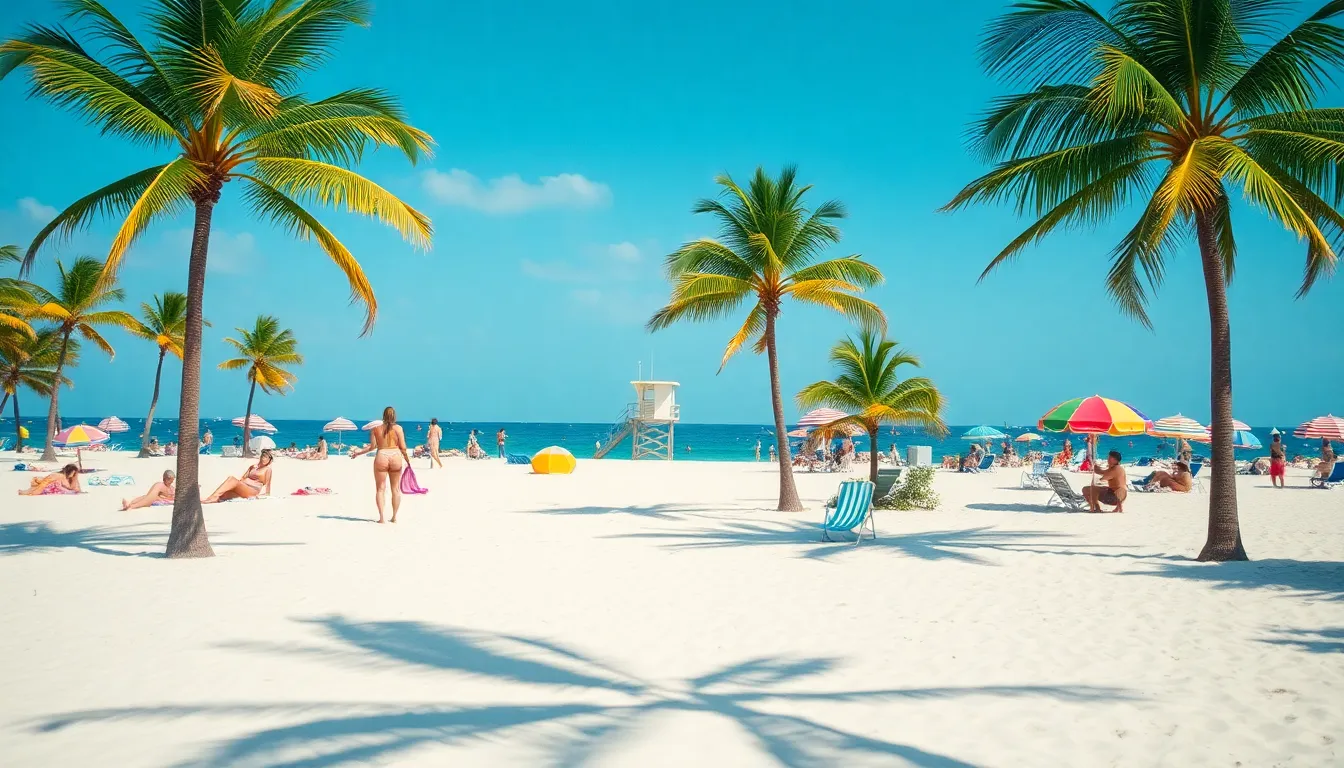Florida, the Sunshine State, is famous for its endless summer and stunning coastlines. But just how many beaches does this tropical paradise boast? Spoiler alert: it’s more than you can count on one hand and probably even one foot! With over 800 miles of coastline, Florida’s beaches are like a buffet of sun, sand, and surf, each offering a unique flavor to satisfy every beach lover’s craving.
Table of Contents
ToggleOverview of Florida’s Beaches
Florida boasts over 1,300 miles of coastline, making it a premier destination for beach lovers. Varied environments exist, from bustling resorts to serene and untouched stretches of sand. Its beaches cater to different interests, including family-friendly spots and vibrant party atmospheres.
Some popular beaches include Clearwater Beach, known for its soft white sand and clear waters. South Beach attracts visitors with its lively nightlife and Art Deco architecture. St. Augustine Beach offers historical charm alongside beautiful coastal views.
Unique ecosystems enhance many Florida beaches, with diverse wildlife thriving in these areas. The state’s commitment to conservation preserves habitats, ensuring that both visitors and local species benefit. Protected areas, like the Florida Keys, showcase striking coral reefs and marine life.
Beach activities abound, such as snorkeling, surfing, and sunbathing. Annual events keep the atmosphere lively, featuring sandcastle competitions and beach volleyball tournaments. Various amenities support beachgoers, including parking, restrooms, and dining options.
Access to beaches remains user-friendly, with numerous public access points statewide. Beach maps help visitors locate their favorite spots efficiently. Diverse culture and recreational opportunities contribute to Florida’s reputation as a top beach destination, drawing millions of visitors each year.
The Count of Beaches in Florida

Florida boasts approximately 1,350 miles of coastline that hosts over 800 beaches. Each beach offers unique features, catering to different preferences and activities.
Public vs. Private Beaches
Public beaches in Florida provide access to everyone, with amenities such as restrooms, lifeguards, and picnic areas. Many of these beaches, like Siesta Key, attract large crowds due to their family-friendly atmosphere. Private beaches, in contrast, require access through hotels or memberships, offering a more exclusive experience. Examples include beaches at resorts like the Ritz-Carlton in Naples. Both beach types contribute to Florida’s diverse coastal landscape, allowing visitors to choose according to their needs.
Major Beach Destinations
Major beach destinations in Florida include Clearwater Beach, South Beach, and Daytona Beach. Clearwater Beach is known for its expansive stretch of soft sand and vibrant nightlife, drawing thousands each year. South Beach stands out with its iconic Art Deco architecture and cultural events. Daytona Beach attracts motorsport enthusiasts with its unique drive-on beach feature. Other notable areas like St. Augustine Beach blend history with scenic views, appealing to tourists with varied interests. Each destination enhances Florida’s reputation as a premier beach goer’s paradise.
Unique Characteristics of Florida’s Beaches
Florida’s beaches exhibit a variety of stunning characteristics that set them apart. The coastal landscape offers breathtaking scenery and diverse ecosystems, attracting millions of visitors annually.
Barrier Islands and Coastal Features
Barrier islands line much of Florida’s coast and protect the mainland from erosion and storm surges. These islands, such as Sanibel and Captiva, present diverse habitats for wildlife while boasting miles of pristine sandy shores. Coastal features like tidal pools and dunes enrich the environment, allowing for exploration and education. Some areas also feature mangroves, which play a crucial role in coastal ecosystems by providing shelter for fish and birds. Unique formations, such as the vibrant coral reefs off the Florida Keys, enhance the underwater experience for snorkelers and divers.
Popular Activities and Attractions
A multitude of activities awaits beachgoers in Florida. Sunbathing and swimming are favorite pastimes at well-known spots like Clearwater Beach and Miami’s South Beach. Surfing enthusiasts frequent places like Sebastian Inlet, known for its consistent waves. Additionally, engaging events, such as beach volleyball tournaments and art festivals, draw crowds throughout the year. Wildlife watching remains popular, especially during sea turtle nesting season. Nearby attractions like amusement parks and historic sites further entice visitors, making Florida’s beaches a dynamic destination for everyone.
Environmental Considerations
Florida’s beaches face numerous environmental challenges, making conservation efforts crucial for their preservation.
Conservation Efforts
Conservation initiatives focus on protecting vulnerable ecosystems along the coast. Organizations work to restore habitats that support diverse wildlife, especially in areas like the Florida Keys. Efforts include monitoring sea turtle nesting sites and removing debris that harms marine life. Partnerships between state agencies and non-profits foster awareness among beachgoers about responsible practices. Public education campaigns emphasize the importance of keeping beaches clean and respecting natural habitats. Conservationists advocate for policies that limit development near sensitive coastal areas, ensuring these ecosystems remain intact for future generations.
Impact of Tourism
Tourism significantly affects Florida’s beaches, generating economic benefits and environmental challenges. Many visitors flock to popular spots, often leading to over-crowding and habitat disruption. Increased foot traffic can contribute to erosion and pollution, impacting local wildlife. Beach cleanups and awareness campaigns aim to mitigate these effects by encouraging responsible tourism. Local economies depend on beach tourism, emphasizing the need for a balance between enjoyment and conservation. Sustainable tourism practices help protect the natural beauty of Florida’s coastline while ensuring it remains a desirable destination.
Florida’s beaches are a treasure trove of natural beauty and diverse experiences. With over 800 beaches along its extensive coastline, the state caters to every type of beachgoer. From the vibrant atmosphere of South Beach to the tranquil shores of St. Augustine Beach, there’s something for everyone.
The commitment to conservation and protection of these unique ecosystems ensures that Florida’s beaches remain pristine and inviting. As visitors explore these coastal gems, they contribute to the local economy while also playing a vital role in preserving the environment. Balancing enjoyment with responsible practices is key to maintaining Florida’s status as a top beach destination for generations to come.




